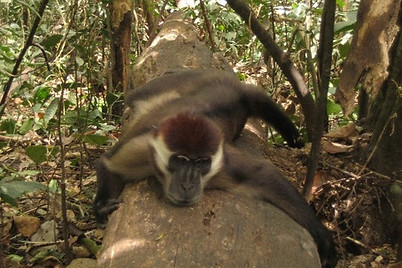Photo by CERCOPAN

Primate Models of Infectious Disease
The study of primate disease ecology can advance our understanding of the relationships between behavior, infectious disease risk and health in humans. Ultimately, we are interested in how environmental and social change affects these processes in both humans and wildlife alike. We address these questions using primates as model systems, investigating characteristics of hosts that predispose exposure risk to novel pathogens or altered infectious disease dynamics. Teasing apart causative pathways in observational studies of wild primates is inherently difficult. In the past, our work has used field experiments, in which parasites are removed from hosts, or animals experience rapid and unexpected changes in their environment, to measure responses to exposures in a more controlled fashion. Results from this work can be applied to human societies experiencing new health threats, such as those experiencing environmental or socio-political displacement. Thus, by extending the concept of primates as models of human health, a typical lab paradigm, to afflictions of populations and societies, our research endeavors to link primate health and conservation to broader global issues.
Social proximity is the best indicator of infection risk
Within a population, only a few individuals typically harbor the majority of infections from macroparasites. This pattern is widespread across animals. Predicting the characteristics that predispose certain individuals to infection has proven more difficult. For one, parasite communities are dynamic, yet typically measured at only a single point in an individual’s lifetime. Determining whether host behaviors associated with parasitic infection are the cause or consequences of infection presents an additional challenge.
By experimentally removing parasites of primates we were able to measure rate of reinfection alongside host behavior and physiology. Proximity to other individuals, but not individual stress, put individuals at increased risk of infection. Heightened risk of infectious diseases has long been considered a cost of sociality in humans and primates, and this work suggests that the mechanism by which individuals experience incresed risk is through contact with other animals and/or contaminated pathways rather than stress induced immunosuppression from life in competition with others.


Parasites induce physiological stress and sickness behavior

“Sickness” behaviors, often viewed as maladaptive consequences of infection, can in fact be an adaptive host responses that limit energy expenditure or reduce contact with contaminated areas or individuals. Through a parasite removal study we found that parasites induced a host stress responses, and that infected animals spent more time engaged in behaviors that conserved energy (e.g. resting) at the expensive of foraging for food. Group cohesiveness reduced when individuals were infected with parasites, and this was also seen in a similar study of experimentally dewormed vervets. Primates may reduce proximity to other group mates to avoid risky infection risk, especially given that proximity increases rate of infection (described above). These responses to infection appear to maximize energy
balance, reduce risk of transmission from infected conspecifics, and increase host ability to defend themselves against competition and predation.
Coughing monkeys, crabs, lung parasites and local medicines
Why do monkeys cough? Why do nearby human populations use monkeys to cure cough? And what is going on with those forest crabs that scurry across the forest floor? Turns out the answers have one thing in common. The lung fluke, Paragonimus africanus, is transmitted to humans through consumption of raw or undercooked crab. The infective stage of the parasite hatches in the intestine, migrates from the small intestine through the abdominal cavity, and settles in the lungs where it finds a partner and mates. The eggs are coughed up, sometimes swallowed, and can be found in the feces.


We found them in coughing red-capped mangabeys in an area where hunters report seeing monkeys cough in the forest as reason for using them in traditional medicine. Some monkeys cough because of lung parasites, and coughing monkeys might be a good surveillance tool for Paragonimus in Nigeria, which is currently re-emerging in human populations. This story illustrates one of many intriguing links between wildlife infectious disease, conservation and human health in Nigeria.
Supported by:
National Science Foundation Doctoral Dissertation Improvement Grant (IOS -1403861)
Fulbright Institute of International Education Scholarship
National Institutes for Health Parasitology and Vector Biology Training Grant
Kohler Fellow at Wisconsin Institutes for Discovery
Graduate Women in Science Ruth Dickie Scholarship
John Ball Zoological Society Wildlife Conservation Grant Award
Robert Wood Johnson Health Foundation Dissertation Grant
International Primate Society Captive Care Grant
Primate Society of Great Britain, Captive Care Working Party